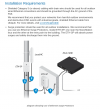Appletax
Well-Known Member
- Reaction score
- 395
- Location
- Northern Michigan
Solution: wireless point-to-point bridge using Ubiquiti products.
-----------
Small car dealership has a nice Linksys MR9000 wireless router connected to Charter Spectrum 100mbps. Works great inside the main office.
They receive a poor signal in their garage (metal building; see image below), which is behind their office in the back. Speeds are 4-5mbps. They want to boost the signal without running cable.
Google distance calc shows 188 feet.
A high-end, home-use-type extender doesn't cut the mustard.
Spoke with Hawking Technology and they recommended this:
Super simple to set-up. Connects to existing router.
Hardest part is mounting it outside and getting the Ethernet cable for it outside, which they might be able to do instead of me.
Do you recommend this or something else?
-----------
Small car dealership has a nice Linksys MR9000 wireless router connected to Charter Spectrum 100mbps. Works great inside the main office.
They receive a poor signal in their garage (metal building; see image below), which is behind their office in the back. Speeds are 4-5mbps. They want to boost the signal without running cable.
Google distance calc shows 188 feet.
A high-end, home-use-type extender doesn't cut the mustard.
Spoke with Hawking Technology and they recommended this:
Super simple to set-up. Connects to existing router.
Hardest part is mounting it outside and getting the Ethernet cable for it outside, which they might be able to do instead of me.
Do you recommend this or something else?
Last edited:


